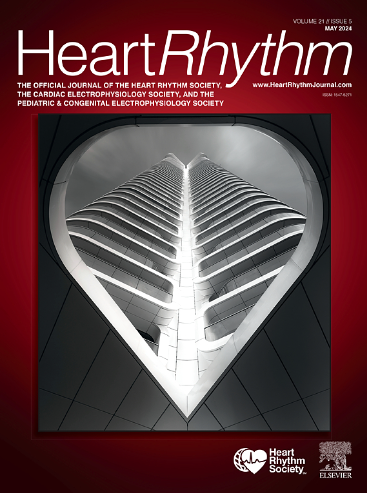接受导管消融术的心房颤动患者缺血性心脏病的预后重要性。
IF 5.6
2区 医学
Q1 CARDIAC & CARDIOVASCULAR SYSTEMS
引用次数: 0
摘要
背景:缺血性心脏病(IHD)与心房颤动(AF)风险增加有关。然而,有关 IHD 在导管消融术后房颤复发中的作用的数据却很少:目的:研究原有或新发的房颤是否与消融术后房颤复发的更高风险有关:方法:利用丹麦全国范围内的登记资料,确定了 2010 年至 2020 年期间在丹麦首次接受房颤消融术的所有患者。主要结果是房颤复发,定义为消融术后 1 年内房颤相关入院或使用抗心律失常药物,不包括 3 个月的空白期。IHD 的定义是 ICD-10 诊断为 IHD 和/或既往冠状动脉血运重建:在12,162名首次接受房颤消融术的患者中(平均年龄62岁,30%为女性),20%患有既往的IHD。在单变量对数二项式逻辑回归(相对风险 (RR) 1.09,95%CI 1.04-1-14,p)中,既往存在的 IHD 与房颤复发风险增加有关:房颤消融术的有效性似乎并不会因为存在心肌缺血而降低。然而,房颤消融术后出现的心肌缺血可能成为房颤的触发因素,而之前的消融术未能充分抑制心肌缺血。本文章由计算机程序翻译,如有差异,请以英文原文为准。

Prognostic importance of ischemic heart disease for patients with atrial fibrillation undergoing catheter ablation
Background
Ischemic heart disease (IHD) has been linked to an increased risk of atrial fibrillation (AF). However, data are sparse regarding the role of IHD in AF recurrence after catheter ablation.
Objective
We sought to investigate whether preexisting or new-onset IHD is associated with a greater risk of AF recurrence after ablation.
Methods
With use of Danish nationwide registries, all patients undergoing first-time AF ablation in Denmark from 2010 to 2020 were identified. The primary outcome was AF recurrence defined by AF-related hospital admission or antiarrhythmic drug use within 1 year after ablation excluding a 3-month blanking period. IHD was defined as an International Classification of Diseases, Tenth Revision diagnosis of IHD or prior coronary revascularization.
Results
Of 12,162 patients undergoing first-time ablation for AF (mean age, 62 years; 30% female), 20% had preexisting IHD. Preexisting IHD was associated with an increased risk of AF recurrence in univariable log-binomial logistic regression (relative risk, 1.09; 95% CI, 1.04–1.14; P < .001). However, after multivariable adjustment including procedural year, preexisting IHD was no longer associated with an increased risk of AF recurrence (relative risk, 1.02; 95% CI, 0.97–1.06; P = .42). In a nested case-control study of those without preexisting IHD before ablation (n = 9778), newly diagnosed IHD after ablation was associated with an increased risk of AF recurrence in multivariable analysis (hazard ratio, 3.03; 95% CI, 1.84–4.99; P < .001).
Conclusion
The presence of IHD does not appear to reduce the effectiveness of AF ablation procedures. However, the emergence of IHD after AF ablation may serve as a trigger for AF that is insufficiently suppressed by prior ablation.
求助全文
通过发布文献求助,成功后即可免费获取论文全文。
去求助
来源期刊

Heart rhythm
医学-心血管系统
CiteScore
10.50
自引率
5.50%
发文量
1465
审稿时长
24 days
期刊介绍:
HeartRhythm, the official Journal of the Heart Rhythm Society and the Cardiac Electrophysiology Society, is a unique journal for fundamental discovery and clinical applicability.
HeartRhythm integrates the entire cardiac electrophysiology (EP) community from basic and clinical academic researchers, private practitioners, engineers, allied professionals, industry, and trainees, all of whom are vital and interdependent members of our EP community.
The Heart Rhythm Society is the international leader in science, education, and advocacy for cardiac arrhythmia professionals and patients, and the primary information resource on heart rhythm disorders. Its mission is to improve the care of patients by promoting research, education, and optimal health care policies and standards.
 求助内容:
求助内容: 应助结果提醒方式:
应助结果提醒方式:


